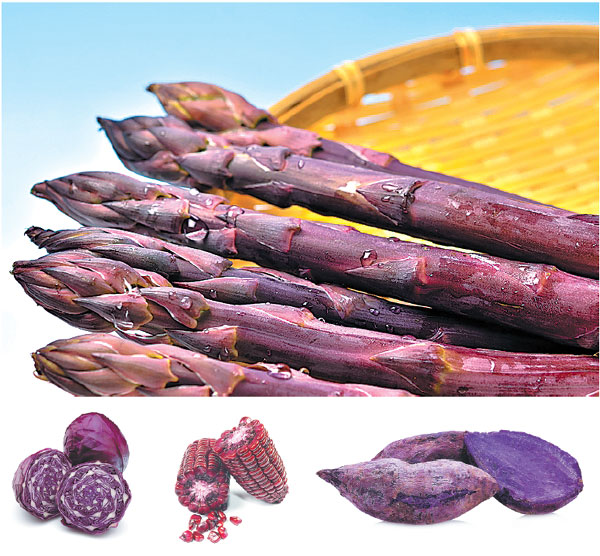Start eating purple for good health
By Joanna Freedman (China Daily) Updated: 2017-02-05 14:59The science behind 2017's new colorful trend in healthy food
If you've never tried an acai bowl, or tucked into a black rice risotto, then 2017 could be a year of new experiences.
According to experts from Whole Foods, who examined consumer behaviour globally across 465 stores, our plates are going to look very colourful this year, with purple foods in particular expected to fly off the shelves.
In an online statement, the health food company described the phenomenon as a "fast growing trend." They said: "Richly colored purple foods are popping up everywhere: purple cauliflower, black rice, purple asparagus, elderberries, acai, purple sweet potatoes, purple corn and cereal.
"The power of purple goes beyond the vibrant color and often indicates nutrient density and anti-oxidants."
Matthew Plowman, a Nutrition Adviser at Cardiff Sports Nutrition, agrees that purple foods are full of natural health benefits. He said: "The benefits of antioxidants have long been discussed, but they are known to fight disease, keep you looking younger, reduce inflammation and are good for your heart - basically, why wouldn't you eat them?"
Essentially, the darker the colour of a food, the higher the contents of antioxidants and nutrients will be, and the healthier the food. In fact, one health and nutrition study found that those who ate purple fruit and vegetables regularly often had a reduced risk of getting high blood pressure and low cholesterol.
Plowman also argued that the somewhat niche purple food trend is unsurprising, given how health conscious we are becoming as a nation. He added: "As a nation we are all becoming more health conscious. This could be partly put down to social media which has helped to raise awareness of health bloggers, nutritionists and dieticians who are sharing insights into their health tips and inspiring us to make better food choices.
"It's well known that author of the Lean In 15 series, Joe Wicks, helped to increase tenderstem broccoli sales by 25%-proving trends are in the hands of influencers."
If you want to try 2017's colourful new food trend for yourself, then find out the health benefits of some of the purple fruit, veg, and cereals available on the market.
Purple foods to try
1 Purple Corn: Purple Corn is hard to get your hands on. It's a grain that grows primarily in the mountains of Peru, meaning that it's not readily available in most supermarkets. Your best bet of finding it is to look in health food shops, and specialised stores online.
According to Plowman: "Purple corn has one of the highest antioxidant contents... and while it may not be as healthy as purple fruits and vegetables, it has more benefits that it's non-purple counterparts."
2 Purple Sweet Potatoes: While the standard sweet potato is packed with health benefits of its own, the purple sweet potato is even better for us. Also known as Okinawan potatoes, these brightly coloured spuds share the same taste as their orange siblings, but are also filled with anthocyanins, which aid digestion and have anti-inflammatory properties.
3 Acai Berries: Acai Berries have become all the rage in recent years, and now they look set to get even bigger (metaphorically speaking). The berries are found in some slimming pills, and while there are mixed opinions about whether this fruit can aid weight loss, science is clearer on the topic of its general health benefits.
"Acai berries are extremely good for heart health," said Plowman. "They provide cardio-protective benefits to our cells, and lower the cholesterol levels in the blood stream. They effectively help to prevent blood clots, improve blood circulation and relax the blood vessels."
4 Purple Asparagus: Originally from Albenga, Italy, the purple asparagus is rich in vitamin B, which improves, skin, hair and nails. While this may not make you run to the nearest shop, the purple asparagus has also been praised for its laxative properties, and has been used used since the Roman times to improve bowel movements. It's also great for the immune system, as its rich in vitamins A, C and K.
5 Black Rice: Once described as the "forbidden rice" due to the fact it was produced on a much smaller scale than brown or white grains, black rice has a whole host of health benefits. It's high in iron and vitamin E, which has been known to fight aging and combat heart issues, and it has a mild, nutty flavour.
Plowman noted: "Black rice is by far better for you than its white or brown alternatives - its antioxidant level is around 6 times higher. Its even been found to outdo blueberries, which have been long considered the number one choice for antioxidant properties."
|
Purple asparagus, sweet potatoes, corn and cabbage. The vibrantly dark color-also found in berries and rice - indicates a rich source of nutrients and antioxidants, nutrition experts say.Photos Provided To China Daily |
- 'Cooperation is complementary'
- Worldwide manhunt nets 50th fugitive
- China-Japan meet seeks cooperation
- Agency ensuring natural gas supply
- Global manhunt sees China catch its 50th fugitive
- Call for 'Red Boat Spirit' a noble goal, official says
- China 'open to world' of foreign talent
- Free trade studies agreed on as Li meets with Canadian PM Trudeau
- Emojis on austerity rules from top anti-graft authority go viral
- Xi: All aboard internet express












